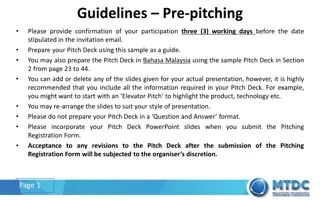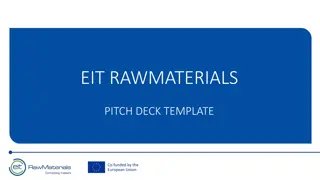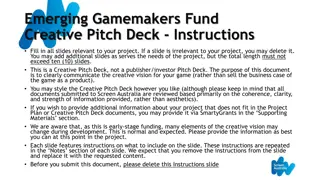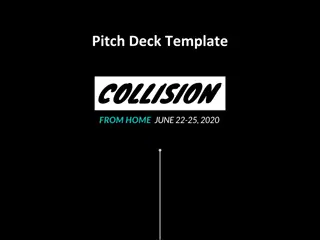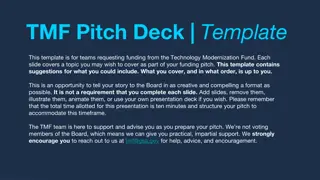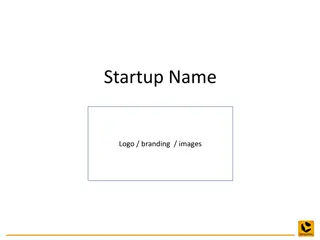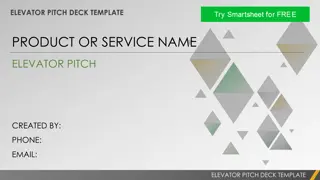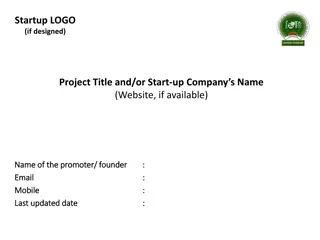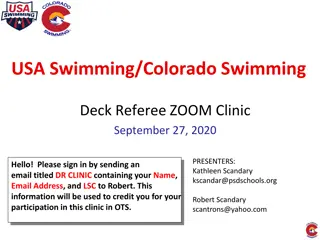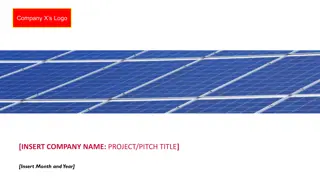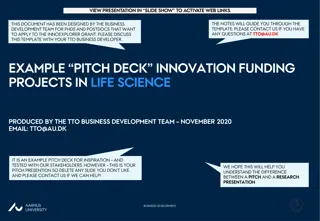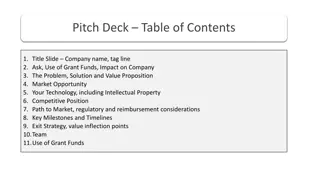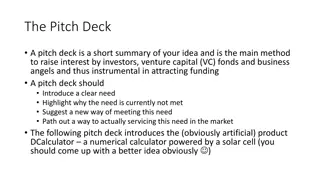Effective Pitch Deck Guidelines and Examples
Crafting a well-structured pitch deck is crucial for communicating your business to potential investors effectively. Key considerations include showcasing growth, building a competitive product, addressing a sizable market, and having a clear vision and financial forecasts. Learnings from Harvard Business School emphasize brevity, design importance, and clarity in delivering messages across slides.
Download Presentation

Please find below an Image/Link to download the presentation.
The content on the website is provided AS IS for your information and personal use only. It may not be sold, licensed, or shared on other websites without obtaining consent from the author. Download presentation by click this link. If you encounter any issues during the download, it is possible that the publisher has removed the file from their server.
E N D
Presentation Transcript
Pitch Deck Guidance Guidance notes with examples In partnership with: Sources and notes 1
INTRODUCTION A well-structured pitch deck is the fastest, easiest way for you to explain your business to investors. It is a visual summary of your business plan and the related investment opportunity Investors are looking for an opportunity to invest early in a new business with the potential for significant return on investment and a high chance of success Key factors that investors consider when accessing your Pitch Deck: Have you demonstrated a consistent track record of delivering growth? Have you built a compelling product with sustainable competitive advantages? Are you addressing a large, growing market? Can you articulate your vision and growth strategy clearly and concisely? Are your financial forecasts ambitious but accurate? Do you have a talented, experienced, and focused team to build a successful business with sustainable growth? Are you clear about what external investment is required and how it will be spent? Key learnings from Harvard Business School s study of 200 Series Seed and Series A rounds completed by US companies: Keep your pitch deck to 20 pages or fewer Spend time creating and designing your deck. In particular, make sure your team slide and financials slide look great, as these are likely to be your most viewed slides Viewers studied the average successful pitch deck for 3 minutes and 44 seconds and 12% did this using their mobile phones. This highlights the importance of delivering clear and concise messages on each slide Source: Pitch Deck Coach, Harvard Business School, DocSend 2
TYPES OF INVESTOR COLLATERAL The focus of this template is the pitch deck, which is a 15 20 slide confidential document designed to be sent to qualified potential investors. This can be a 'One-to-Many' or a 'One-to-One' format. Content light Content heavy Information Flyer One-to-Many Pitch Deck One-To-One Pitch Deck Information Memorandum (IM) A non-confidential teaser document which provides an overview of the business and the capital raising process A confidential document (typically 10 15 slides in length) which provides information about the business A confidential document (typically 15 20 pages or slides in length) which provides information about the business A confidential document (typically 20+ pages or slides in length) which provides information about the business The Flyer is sent to potential investors to invite them to participate in the process Designed to be presented by your management to a crowd (e.g. NZTE showcase, angel events, accelerator/incubator, demo days) Designed to be a stand-alone document that is sent to qualified potential investors to be read Designed to be a stand-alone document that is sent to qualified potential investors to be read A more detailed version of the 'One-to Many' Pitch deck' (which is highly visual as it is spoken to) This document is the most content heavy and provides a high level of insight into the business Qualified potential investors are selected to attend NZTE showcases or management presentations At NZTE the majority of companies and investors we work with prefer to use Pitch Decks as opposed to IM s This document is a simplified, more visual version of the One- to-One pitch deck Notes: Throughout the guidance notes we have provided example slides for reference. These should be tailored to suit your company. Visuals should be increased and text decreased for One-to-Many presentations. For a One-to-One there needs to be enough detail that the document can stand alone. 3
RECOMMENDED PITCH DECK STRUCTURE NZTE s recommended pitch deck structure is consistent with the observed structure from Harvard Business School s study of 200 US companies Series Seed / A rounds and Sequoia s recommended order Observed order from a study of 200 US companies Series Seed / A rounds: NZTE / Pitch Deck Coach s recommended order: Sequoia s recommended order: Front cover (business idea / vision) Front cover Front cover Problem Problem Problem Solution Solution Solution Why Now Why Now Product Market opportunity Market opportunity Market opportunity Product Competition Competition Team Product Business model Channels / Go to Market / Customers / Case study (you chose) Business model Business model Competition Team Growth strategy / Roadmap Financials Financials Traction / Financials Team Capital raising Source: Pitch Deck Coach, Harvard Business School, DocSend NZTE recommended slides also includes three optional slides: investment highlights slide, demo / video slide and a milestones slide 4
FRONT COVER Announce your business idea and / or vision to investors Catch the investor s attention with a compelling image and announce your business idea and / or vision in one simple declarative statement You want investors to understand what your company does at the beginning, and entice them to want to hear more New Zealand and international examples of the idea / vision statement include: Book rooms with locals, rather than hotels AirBnB Helping people learn to play musical instruments, by making practise fun, and making it a habit - Melodics Wine maturation, redefined Wine Grenade Mint is a quick and easy way to track your spending online - Mint Innovation Other features we suggest including are: Date of preparation (month and year1) Company logo Strictly private and confidential Source: Pitch Deck Coach, Piktochart, various New Zealand and international companies pitch decks 1 The date should be updated each time it is presented / sent to an investor. Investors may be put off by old-dated Pitch Decks 5
INVESTMENT HIGHLIGHTS This is a teaser for what is to follow in the pitch Summarise your investment highlights. This is your chance to introduce the 5 6 key compelling messages of your pitch deck If you have any traction make sure you highlight it here. Traction provides instant validation of your business and credibility of your team If your founder / team is particularly strong, highlight it here and provide detail of why this is the case We suggest using this slide for the One-To-One pitch deck but removing it for the One-To-Many pitch deck Source: Pitch Deck Coach, various New Zealand and international companies pitch decks 6
PROBLEM Explain the problem you solve or the unmet need you address in simple terms that any investor can understand Describe the problem you solve, who you solve it for, and the reasons why your target customers are frustrated with current solutions An effective way to communicate the problem is through story, which allows potential investors to visualise / personalise the issue. In addition, providing numbers can help potential investors understand the magnitude of the problem New Zealand and international examples of the problem description include: There is no effective, trusted way for professionals to find and transact with each other online - LinkedIn $22 million worth of gold goes to waste every year in New Zealand Mint No easy way exists to book a room with a local - AirBnB The Problem slide is the setup for your Solution slide and, later, your Competition slide Source: Pitch Deck Coach, various New Zealand and international companies pitch decks 7
SOLUTION Describe your solution and how you solve the problem Questions that you should address: What is your solution and how does it solve the problem? What are the major benefits of your solution for each of your target customers and users? Do not focus on product features here, these should be presented in your Product slide Explain why your solution is superior to current solutions. If current solutions are slow, expensive, and difficult to use then what is your solution? Hopefully faster, less expensive and easier to use International examples of the solution description include: A web platform where users can rent out their space to host travellers to: save money, make money, and share culture AirBnB YouTube provides a community that connects users to videos, users to users, and videos to videos - YouTube It s all about hooking your audience. You need to describe your business using as few words as possible. Imagine telling a 5-year-old what your business is about Source: Pitch Deck Coach, Piktochart, various New Zealand and international companies pitch decks 8
PRODUCT Show what your product / service is and how it works This is your chance to highlight the key features of your product / service and show it in action If you have multiple products / services be sure to focus solely on your core products / services you don t want to confuse the audience this early on Source: Pitch Deck Coach 9
DEMO / VIDEO (OPTIONAL) Show what your product / service is and how it works in a video We suggest incorporating a brief video that shows your product / service to bring it to life for potential investors for a One-to-Many pitch Be careful with a video in a one-to-one format as investors opening on email or phone may have difficulty watching. Often better to use photos / screenshots Source: Pitch Deck Coach 10
MARKET OPPORTUNITY Estimate the total market opportunity for your product / service and forecast market growth Present the overall market opportunity size, i.e. the revenue opportunity that is available to your product / service if 100% market share was achieved The goal is to derive the most granular, accurate market size possible, which requires careful consideration and analysis of: The market verticals / sub-sectors that you operate in The geographies (at a city or country level) that you operate in or expect to enter during the forecast period Key considerations relating to verticals / sub-sectors include your business model (B2C, B2B, B2G) and position in the supply chain (raw materials, manufacturer, distribution, wholesale, retail) Key information to present here is the size of the market ($), forecast market growth (%), and major players by revenue ($) or market share (%) Investors prefer to invest in markets that are growing versus markets that are stagnant or shrinking It is important that you can explain the rationale for your numbers and that your market numbers and growth prospects are well researched and backed up with qualified, third party data Source: Pitch Deck Coach, Lloyds Development Capital 11
COMPETITION Compare your company to your close competitors using value attributes to highlight your competitive advantage Your Competition slide is your chance to demonstrate your understanding of your competitors and the competitive advantages / points of differentiation of your product / service Once you have selected your close competitors, you will need to agree on the most appropriate value attributes to use for comparison There are various ways you can present this analysis. We suggest using a value grid (2x2 matrix), which displays your company s position on the value grid relative to selected close competitors using the two most important value attributes Do not make the mistake of saying you have no competitors You can loose credibility fast. A market with no competitors can suggest to investors that you do not understand your market, your market does not exist, or your market is too small to be worth pursuing If you are pioneering a new technology, your competition may be the old manual method currently being used (e.g. Uber vs. taxi) Source: Pitch Deck Coach 12
BUSINESS MODEL Detail how you intend to charge customers and make a profit A business model is a holistic description of how a company intends to make a profit, including how it creates, delivers and captures value Creation: How does your product create value for customers? Describe how the product / service you offer is worth more to customers than it costs to produce Delivery: How will you deliver your product to customers? How will customers become aware of your company (marketing etc.)? Capture: How does your company capture part of the value it creates for customers? i.e. this will be dependent on the competitive pricing environment and the value split between you and your customers Your solution and product slide should cover value creation so the focus here is how your company will deliver your product / service and capture value Investors are trying to understand the monetisation of the service or product; We need to show not only the revenue equation but also the key elements on the cost side, so at a snap shot / glance they can get an understanding of the business Source: Pitch Deck Coach 13
CHANNELS / GO TO MARKET / CUSTOMERS / CASE STUDY Choose the slide that best fits into your Pitch Deck Choose the slide that best fits with your company and Pitch Deck Does your company have a strong go-to-market plan? Do you have a set of highly regarded customers already on board? Do you have interesting channels which may require explanation? Do you have a very appealing case study that shows off your company s success through a real life example? Source: Pitch Deck Coach 14
GROWTH STRATEGY / ROADMAP Articulate a clear plan to achieve strong growth over the next 3 to 5 years Explain how you plan to scale your business Investors want to be convinced that you know how to transform a competitive product for a large, growing market into a substantial, sustainable business. Any successful business executes well on these three operational activities: Customer acquisition: How does your sales and marketing team create awareness and generate demand for your product to acquire new customers? Product innovation: How does your product development team keep enhancing and extending your solution so that it remains competitive or innovate new solutions? Customer retention: How does your customer service team keep your existing customers happy so you don't lose them to your competitors? Source: Pitch Deck Coach, Lloyds Development Capital 15
MILESTONES (OPTIONAL) Demonstrate your consistent track record of achieving growth (such as users, revenue, or earnings) and milestones Investors will look for a consistent track record of delivering growth in order to provide a level of comfort that the business and management team can deliver future growth If you have acquired customers, there must be a market for your product, you must have a competitive product, and you must have demonstrated enough operational expertise to successfully market and sell your product to at least some of the customers in your market Relevant metrics can differ by company and industry. Some examples include: Revenue metrics such as monthly recurring revenue, average revenue per user, monthly churn rate Earnings and cash flow metrics SaaS metrics such as customer acquisition costs, lifetime value of customer, total number of paying customers, monthly active users Per Stuart Miller, founder of supply chain technology firm ByBox, which raised 37.5m of equity from LDC in 2016: Don t worry if the actual numbers are small as long as they are rising. What matters is that the trend is upwards. Sales growth is the evidence [investors] are looking for Source: Pitch Deck Coach, Lloyds Development Capital 16
TRACTION / FINANCIALS Present summary historical and forecast financial information from your financial model Financial forecasts should be ambitious but achievable, based on the track record of your business and the scale of the opportunity ahead You should have a strong understanding of the assumptions used to generate your forecasts, such as your revenue drivers and the amount of money you will spend on key operations such as marketing, sales, product development, and customer service. Forecasts should also directly relate to your growth strategy slide Suggestions relating to presenting financial information: Provide 3 years of forecast data Use graphs and or tables to present the information in an easy to read format Include earnings margins and growth percentages to save investors having to do math in their head Source: Pitch Deck Coach, DocSend 17
TEAM Highlight that your team has the experience and expertise to deliver your forecast growth and create a stronger business Information we suggest to include: Number of years with your company Previous work experience in similar start-ups, technology, or markets Education / qualification We believe it is important to use high quality photos and a consistent format Note: creating an advisory board is a simple way to add industry expertise to your "team Source: Pitch Deck Coach, DocSend, LDC 18
CAPITAL RAISING Provide details of the investment opportunity, including the amount shareholders are seeking to raise and the uses of funds This is your time to provide details of your capital raising, which should tie back to your financial model and growth strategy. We suggest including: The dollar amount you are seeking to raise The uses of funds raised Your pre-money valuation (optional) If you are asking for an investor s cash then you better be sure what you are going to do with it. Focus on meeting frequent but meaningful objectives that prove real progress Source: Pitch Deck Coach, Lloyds Development Capital 19
COMMONLY ASKED QUESTIONS FROM INVESTORS You should be prepared to answer the following questions from potential investors after they have reviewed your pitch deck. It is also useful to consider these as you create your pitch deck 1. Why are you unique in the market? 2. Why is your solution needed now? 3. How is your company going to scale to a size that an investor is this round could get a 10( 20)x return and when? 4. Other than capital, what are your top 2 or 3 limitations to achieve scale? 5. How do you plan to mitigate these limitations? 6. What might be the next disruptive influence on your business? (Current example would be AI) 7. What is your company s plan to deal with disruptive technologies? 8. Who are your top three competitors and how do you differentiate? How will you advance or even maintain this in the face of global competition? 9. In your team, where is the weak link? 10. Where do you personally want to be in five years time? 11. Why are you the right person (at the moment) to invest in? Are you the right person to lead this company to international scale? 12. In regards to the next key market for expansion, how will you get traction and who will you leverage off to do so? 13. Are you ready for an investor who will drive you hard to achieve top and bottom line milestones? Source: NZTE 20
CONTACT www.nzte.govt.nz/en/invest Sources and notes 21

 undefined
undefined







